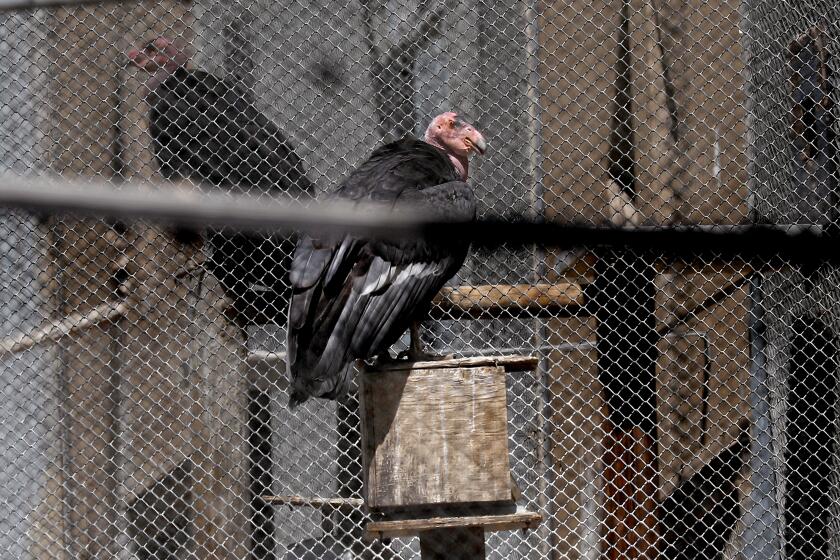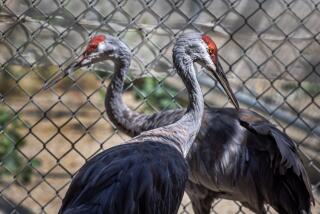After more than a century, California condors soar over Yurok tribal lands once again

After being pushed to the brink of extinction, California condors have returned to a slice of Northern California habitat for the first time in 130 years. On Tuesday, four of the big birds flew the coop after being born in a captive-breeding program.
A livestream from the Yurok Tribe and the Redwood National and State Parks went live at 8 a.m. but the birds did not seem too bothered by their schedule. The New World vultures selected for the momentous occasion betrayed little on whether they would take flight from their designated staging area in Northern California near the Klamath River.
On Tuesday morning, Yurok Wildlife Department Director Tiana Williams-Claussen, a Yurok citizen and traditional culture bearer, narrated the event in hushed tones near the birds’ pen.
Two condors being reared at the Northern California Condor Restoration Program in Northern California spread their wings in their pen. On Tuesday, four condors were released into the wild near the Klamath River. (Northern California Condor Restoration Program)
“I am just overjoyed on this day,” Wiliams-Claussen whispered to the hundreds of viewers over the livestream.
“I know you love condors as much as I do,” she said. “Right now, it’s just a waiting game.”
In the morning light, the birds stretched their wings, which can reach up to 9½ feet, and groomed one another in an intimate huddle. They dined on a carcass and then perched atop their pen in a staging area.
Ivan Gomez found guilty of arson in the 125,000-acre Dolan fire near Big Sur and cruelty to animals for killing multiple condors, prosecutors said.
The chat box in the Facebook feed exploded with exclamation points and emojis as the birds approached a trap door that led to the final pen before their release. Two male birds, simply marked A2 and A3, were the eager ones that made their way to the area. Williams-Claussen stepped away from the stream just after 10 a.m. as the birds were let out. One last time, the birds stretched their wings and without any instruction flew into the air.
“That was just as exciting as I thought it would be,” Williams-Claussen said when she returned to her computer. “Those guys just took off.”
She added, “I am just so happy and proud to be here today.”
The transition to the wild comes after a lifetime raised in captivity for the condors, where they learned to stretch their wings in large flight pens. Biologists refer to the scavengers as social birds that pick up their life skills from elders. This particular group was raised with an older bird, which acts as a sort of lifetime mentor for younglings in captivity.
Even as a Yurok tribe releases California condors on tribal lands, wind farms pose a new threat to the critically endangered species.
Similar releases in Arizona have introduced the condors back into the wild. The birds are considered a nonessential, experimental population under the Endangered Species Act.
Four condors, three males and one female, were selected for the California release on Tuesday from a newly built facility within the Yurok ancestral territory. The Yurok word for condor is prey-go-neesh and the tribe views the bird’s reintroduction as part of its “obligation to bring balance to the world.”
“We’ve been working toward these releases for 14 years,” Williams-Claussen said in a statement. “Now, the condor is coming home.”
Two more birds will be released at a later date.
Biologists will continue to monitor the birds in the wild to make sure they’re adapting to their new surroundings. The birds range between 2 and 4 years old and were raised at a facility in Idaho. They first arrived in California in September and are the product of more than three decades of captive breeding aimed at rescuing the California condor from extinction.
During the Gold Rush in the 1840s, the birds were shot for sport and collected for museums. They were one of the first species placed on the endangered species list and continued to suffer through the 1950s when manmade developments crowded their habitat and the pesticide DDT, now banned in the United States, weakened the condors’ eggshells, making them brittle and frail.
By the 1980s, the wild condor population dwindled to just 22 birds. In 1983, the U.S. Fish and Wildlife Service launched the first captive-breeding programs at the Los Angeles and San Diego zoos. Today there are approximately 300 condors flying in the wild in California and there are several release facilities across the region, according to federal officials.
Tuesday’s release marked a special occasion for biologists working in conjunction with the Yurok Tribe, the Ventana Wildlife Society and the Northern California Condor Restoration Program.
“The reintroduction of condors into Northern California is truly a monumental moment,” said Paul Souza, director of the U.S. Fish and Wildlife Service’s Pacific Southwest region. “This effort builds upon the program’s collective knowledge and history of releasing condors and showcases the benefit of partnering with Tribes and others to implement recovery of listed species. We are proud to support this collaborative to implement recovery of listed species.”
More to Read
Sign up for Essential California
The most important California stories and recommendations in your inbox every morning.
You may occasionally receive promotional content from the Los Angeles Times.














